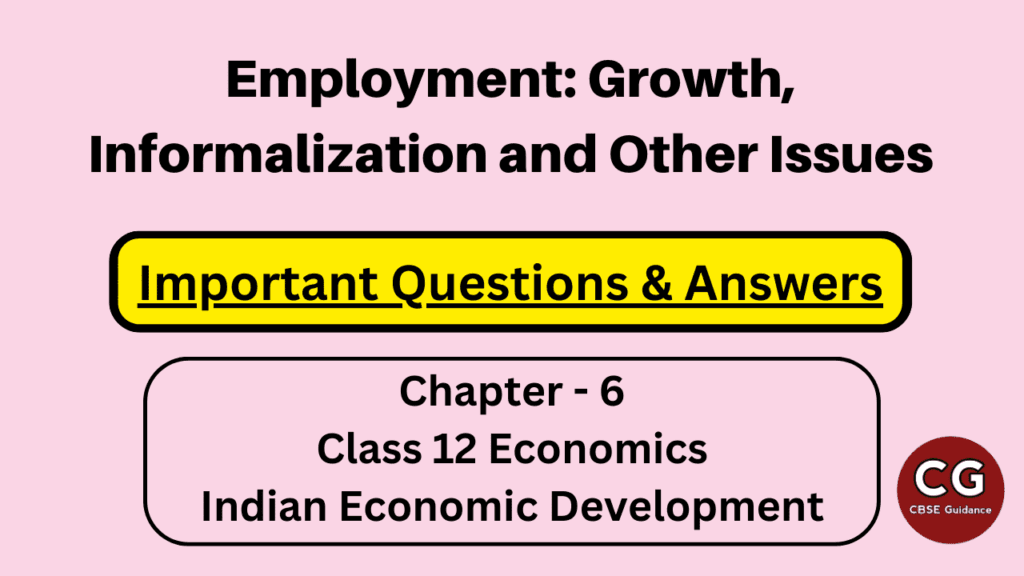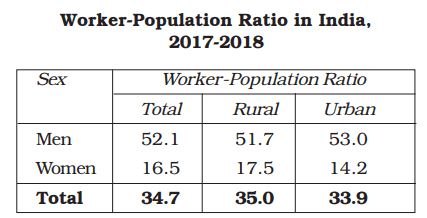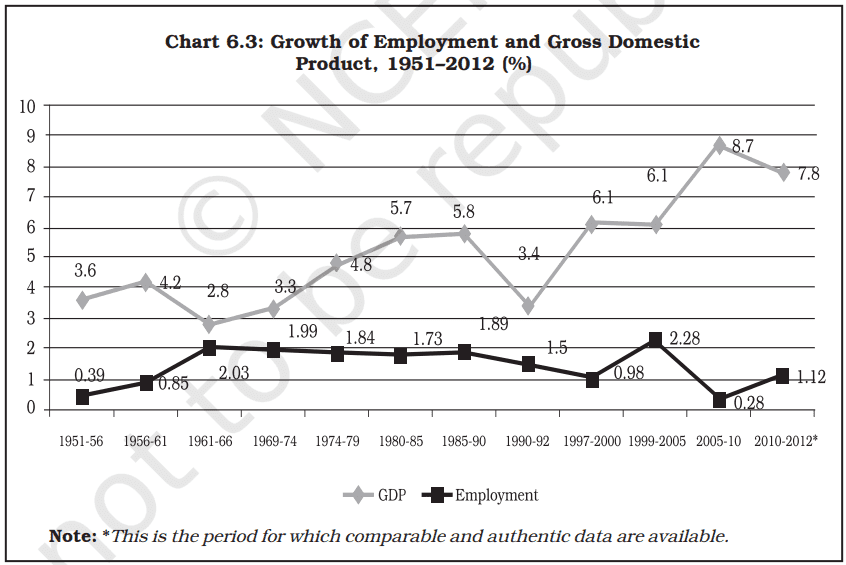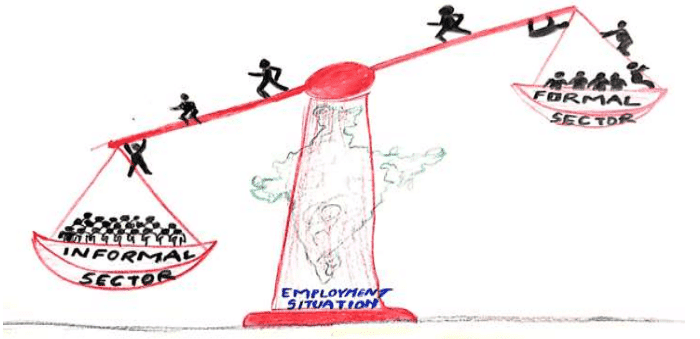Explore crucial Class 12 Economics topics in our comprehensive guide. Get answers to important questions on Indian Economic Development (IED) Chapter 6 Employment: Growth, Informalization, and Other Issues. Prepare for success in your Class 12 exams with expert insights and solutions.

| Board | CBSE and State Boards |
| Class | 12 |
| Subject | Economics |
| Book Name | Indian Economic Development (IED) |
| Chapter No. | 6 |
| Chapter Name | Employment: Growth, Informalization and Other Issues |
| Type | Important Questions & Answers |
| Session | 2024-25 |
"You don't have to be great to start, but you have to start to be great."
- Zig Ziglar
Employment: Growth, Informalization and Other Issues Class 12 Important Questions Answers
Q. No. 1) Multiple Choice Questions (MCQs)
i. Read the following statements carefully:
- Statement 1: The nature of the unemployment problem in India is uni-faceted.
- Statement 2: Worker-population ratio is an indicator used for analyzing the employment situation in a country.
In light of the given statements, choose the correct alternative from the following:
a. Statement 1 is true and Statement 2 is false.
b. Statement 1 is false and Statement 2 is true.
c. Both Statements 1 and 2 are true.
d. Both Statements 1 and 2 are false.
Ans. Option (b)
ii. Informal workers
a. Work in factories
b. Work in government department
c. Do not get social security benefits
d. Form trade unions
Ans. Option (c)
iii. Generally, we divide all economic activities into 8 different industrial divisions. Choose the wrong combinations:
a. Primary sector which includes (i) Agriculture (ii) Communication service
b. Secondary sector which includes (iii) Manufacturing (iv) Electricity, Gas, and Water Supply (v) Construction
c. Service sector which includes (vi) Trade (vii) Transport and Storage and (viii) Services
d. (b) & (c) are wrong combinations
Ans. Option (a)
iv. In rural and urban areas which type(s) of unemployment, is generally found (First rural area unemployment then urban)
- Disguised unemployment
- Industrial unemployment
- Seasonal unemployment
- Open unemployment
Options
a. 1, 2, 4
b. 1, 3, 4
c. 4, 2, 1, 3
d. 4, 1, 2, 3
Ans. Option (b)
v. Why are women, in general, and urban women, in particular, not working?
a. Men are able to earn high incomes
b. Families discourage female members from taking up jobs
c. Many household activities engaged by women are not recognized as productive work
d. (a) & (b)
Ans. Option (d)
vi. Which of the following sources collect data on unemployment?
a. Census Reports of India
b. National Sample Survey Organization’s Reports of Employment and Unemployment Situation
c. Directorate General of Employment and Training Data of Registration with Employment exchange
d. All of the above
Ans. Option (d)
vii. Agriculture is not a major source of employment in urban areas where people are mainly engaged in the service sector. About _____% of urban workers are in the service sector.
a. 50%
b. 55%
c. 60%
d. 65%
Ans. Option (c)
viii. In the Indian economy, during the period of 1951-2012, we were able to produce more goods and services without generating employment. Scholars refer to this phenomenon as _____.
a. Stagnation in growth
b. Jobless growth
c. Informalization of employment
d. Casualization of employment
Ans. Option (b)
ix. Unemployment refers to people:
a. Who are not willing to work
b. Who are willing but do not get work
c. Who leave their jobs in search of better ones
d. Who have been dismissed because of incorrect practices
Ans. Option (b)
x. Poverty alleviation programmes aim at providing not only employment but also
a. Primary health, primary education, rural drinking water, nutrition
b. Assistance for people to buy income and employment-generating assets, development of community assets by generating wage employment
c. Construction of houses and sanitation, laying of rural roads, development of wastelands
d. All of the above
Ans. Option (d)
xi. There are 473 million workers in the country. Out of which, 30 million workers are in the formal sector. Can you estimate the percentage of people employed in the formal sector in India?
a. 94%
b. 06%
c. 69%
d. 21%
Ans. Option (b)
Q. No. 2) Fill in the blanks:
i. _____ is an indicator that is used for analyzing the employment situation of a country.
Ans. Worker population ratio
ii. Under _____ type of unemployment, the marginal product gained by employing one additional unit of labor is zero.
Ans. Disguised
Q. No. 3) Compare and analyze the ‘Women Worker Population Ratio’ in Rural and Urban areas based on the following information:

Ans. The data in the given table reveals that:
- Women constitute 16.5% of the total worker population in the economy.
- The number of women workers in rural areas (17.5%) is relatively higher than the number of women workers in urban areas (14.2%). Due to the abject poverty in rural areas, rural women are compelled to work more than their urban counterparts.
Q. No. 4) The nature of employment in India is multifaceted. Explain in brief.
Ans.
- Some get employment throughout the year; some others get employed for only a few months in a year.
- Many workers do not get fair wages for their work.
Q. No. 5) In urban areas, the worker-population ratio is about 34 whereas in rural India, the ratio is about 35. Why is there such a difference?
Ans.
- People in rural areas have limited resources to earn a higher income and participate more in the employment market.
- Many do not go to schools, colleges, and other training institutions. They discontinue in the middle to join the workforce
- Whereas, in urban areas, a considerable section is able to study in various educational institutions.
- Urban people have a variety of employment opportunities.
- They look for the appropriate job to suit their qualifications and skills.
- In rural areas, people cannot stay at home as their economic condition may not allow them to do so.
Q. No. 6) Compared to urban women, more rural women are found working. Why?
Or,
Why are women, in general, and urban women, in particular, not working?
Ans.
- It is common to find that where men are able to earn high incomes, families discourage female members from taking up jobs.
- many household activities done by women are not recognised as productive work. This narrow definition of work leads to the non-recognition of women’s work and, therefore, to the underestimation of the number of women workers in the country.
Q. No. 7) ‘Casual wage work is the major source of employment in rural India ‘. Defend or refute the given statement with a valid reason.
Ans. The given statement is refuted. In rural areas, non-farm job opportunities are limited. People generally do not show a preference for acquiring skills and training for non-farm occupations. They prefer to stay on family farms and fields as self-employed.
Q. No. 8) Why are regular salaried employees more in urban areas than in rural areas?
Ans.
- Everyone cannot run factories, shops, and offices of various types.
- Moreover, enterprises in urban areas require workers on a regular basis.
Q. No. 9) Study the following chart showing the Growth of Employment and Gross Domestic Product and analyze the trend of the two variables from 1990-2012.

Ans.
- During the period 1950–2010, the Gross Domestic Product (GDP) of India grew positively and was higher than the employment growth. However, there was always fluctuation in the growth of GDP.
- During this period, employment grew at a rate of not more than 2 %.
- In the late 1990s, employment growth started declining and reached the level of growth that India had in the early stages of planning.
- During these years, we also find a widening gap between the growth of GDP and employment. This means that in the Indian economy, without generating employment, we have been able to produce more goods and services. This phenomenon is called jobless growth.
Q. No. 10) a. Why are fewer women found in regular salaried employment?
b. Analyse the recent trends in sectoral distribution of workforce in India:

Ans. a. Lesser women are found in regular salaried employment in India, because:
- jobs generally require skills and a high level of literacy.
- lack of mobility among women in India due to social constraints.
b.
- Distribution of the workforce by industrial sectors shows a substantial shift from farm work to non-farm work.
- In 1972-73, about 74% of the workforce was engaged in the primary sector, and in 2017-18, this proportion declined to about 45%.
- Secondary and service sectors are showing promising future for the Indian workforce. The shares of these sectors have increased from 11 to 24% and 15 to 31% respectively.
Q. No. 11) ‘In recent times the Indian Economy has experienced the problem of Casualisation of the workforce. This problem has only been aggravated by the outbreak of COVID-19.’
Do you agree with the given statement? Discuss any two disadvantages of casualization of the workforce in light of the above statement.
Ans. The given statement is quite appropriate with reference to the ‘casualization of labor’ in India.
- For casual workers, the rights of labor are not properly protected by labor laws. Particularly, during pandemic times, as demand for goods and services fell the casual workers were left jobless, without any compensation or support.
- During the COVID-19 lockdown, millions of casual workers lost their jobs, raising the question of their survival. Also, additional health expenditures added to their troubles. Had such workers been working in the formal sector, it would have given them some respite in their difficult times.
Q. No. 12) Discuss briefly the concept of 'informalisation of workforce', in the context of the Indian economy.
Ans. In recent years, India has witnessed an unprecedented shift in the workforce from the formal sector to the informal sector. This process whereby, the proportion of informal workers in the total workforce increases is known as informalisation of the workforce.
Q. No. 13) Identify the situation depicted in the given image. Suggest the impact of the indicated situation, on the Indian economy.

Ans.
- The given image depicts the drift of the Indian workforce from the formal sector to the informal sector employment. This situation is popularly known as the ‘informalization of the workforce’.
- In India, the informal sector includes millions of farmers, agricultural laborers, non-farm casual wage laborers, owners of small enterprises, and self-employed people. The workforce in the informal sector does not get regular income; they do not have any protection or regulation from the government. Workers may be dismissed without any compensation/notice.
- The Government is taking steps to safeguard the interests of the workers in the informal sector.
Q. No. 14) Is it necessary to generate employment in the formal sector rather than in the informal sector? Why?
Ans. Yes, it is necessary to generate employment in the formal sector rather than in the informal sector. Here are some of the reasons why:
- Social security benefits
- Regular income
- Better working conditions
- Higher productivity
- Tax revenue
Q. No. 15) Write a short note on disguised unemployment, seasonal unemployment, and open unemployment.
Ans. i. Disguised unemployment refers to a situation in which a portion of the workforce is employed in jobs that do not fully utilize their skills, abilities, or labor potential. In disguised unemployment, people are officially employed, but their contribution to the production process is minimal or redundant. Suppose a farmer has four acres of land and he actually needs only two workers and himself to carry out various operations on his farm in a year, but if he employs five workers and his family members such as his wife and children, this situation is known as disguised unemployment.
ii. Seasonal unemployment is a type of unemployment that occurs when there is a temporary decrease in demand for labor during certain times of the year. Work in agriculture is seasonal; there are no employment opportunities in the village for all months of the year. When there is no work to do on farms, people go to urban areas and look for jobs.
iii. Open unemployment, also known as visible unemployment or overt unemployment, refers to a situation in which individuals who are actively seeking employment are unable to find suitable jobs despite their willingness and readiness to work.
Key characteristics of open unemployment include:
- Actively seeking work
- Lack of employment opportunities
- Visible in official statistics
Q. No. 16) Defend or refute the following statement with a valid explanation:
‘Disguised unemployment is a common form of unemployment in rural India’
Ans. The given statement is true. Disguised unemployment is a situation where the marginal productivity of labor is zero. In India, this situation is often witnessed, as farming is more of a family affair in rural areas and most of the members are generally engaged on the farms without any direct contribution to the production process. This problem persists in rural India due to the lesser availability of jobs.
Q. No. 17) Victor is able to work only for two hours a day. Rest of the day, he is looking for work. Is he unemployed? Why? What kind of jobs could persons like Victor be doing?
Ans. Victor can be considered as underemployed rather than unemployed. Unemployment typically refers to individuals who are willing and able to work but cannot find any work at all. In Victor's case, he is able to secure some work for two hours a day, which indicates that he is partially employed. However, he is not fully utilizing his available time and labor potential, which is a form of underemployment.
Some of the jobs that persons like Victor could be doing include:
- Part-time work: This is a common type of underemployment, where a person works less than 40 hours per week.
- Temporary work: This is another common type of underemployment, where a person is only employed for a short period of time.
- Casual work: This is a type of underemployment where a person is not guaranteed work on a regular basis.
- Self-employment: This is a type of underemployment where a person is their own boss and sets their own hours.
- Skill Development: He could use his free time to enhance his skills or education, which could lead to better job opportunities in the future.
Q. No. 18) “Since independence, the government has been playing an important role in generating employment directly or indirectly.” Discuss.
Ans.
- Various government departments/enterprises employ people and increase their output of goods and services, leading to direct employment.
- When the output of goods and services from government enterprises increases, then private enterprises that receive raw materials from government enterprises will also raise their output. Subsequently, private enterprises using these outputs are indirectly benefitted from the increase in the scale of production. This leads to an increase in the number of employment opportunities indirectly in the economy.
| Also Read: Class 12 Important Questions Class 12 Notes |
Hope you liked these Important Questions and Answers on Class 12 Economics Indian Economic Development Chapter 6 Employment: Growth, Informalization, and Other Issues. Please share this with your friends and do comment if you have any doubts/suggestions to share.